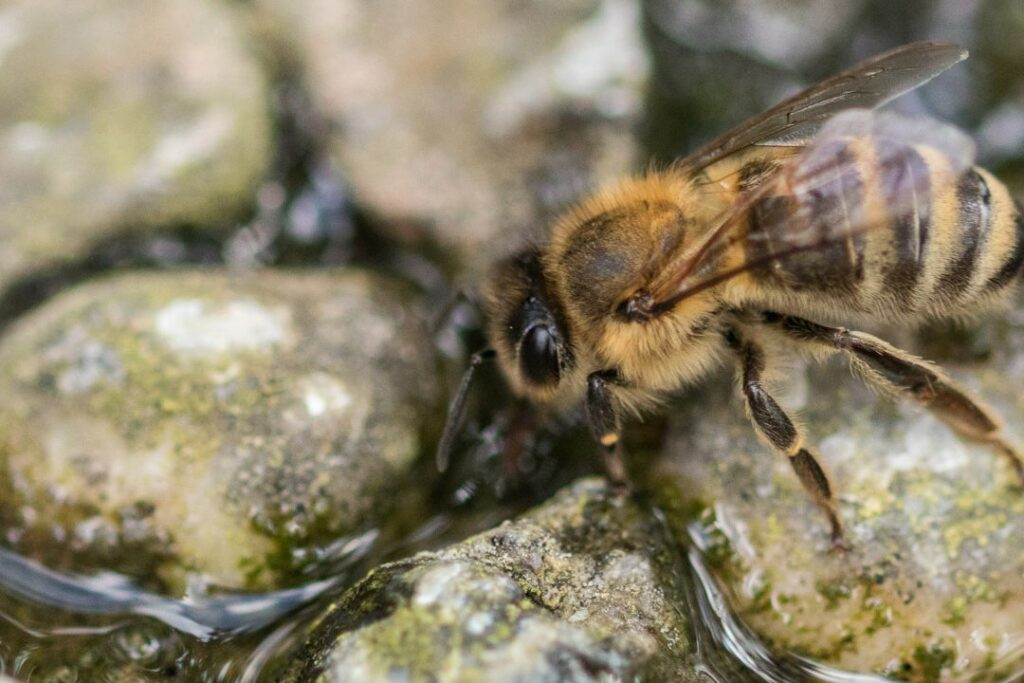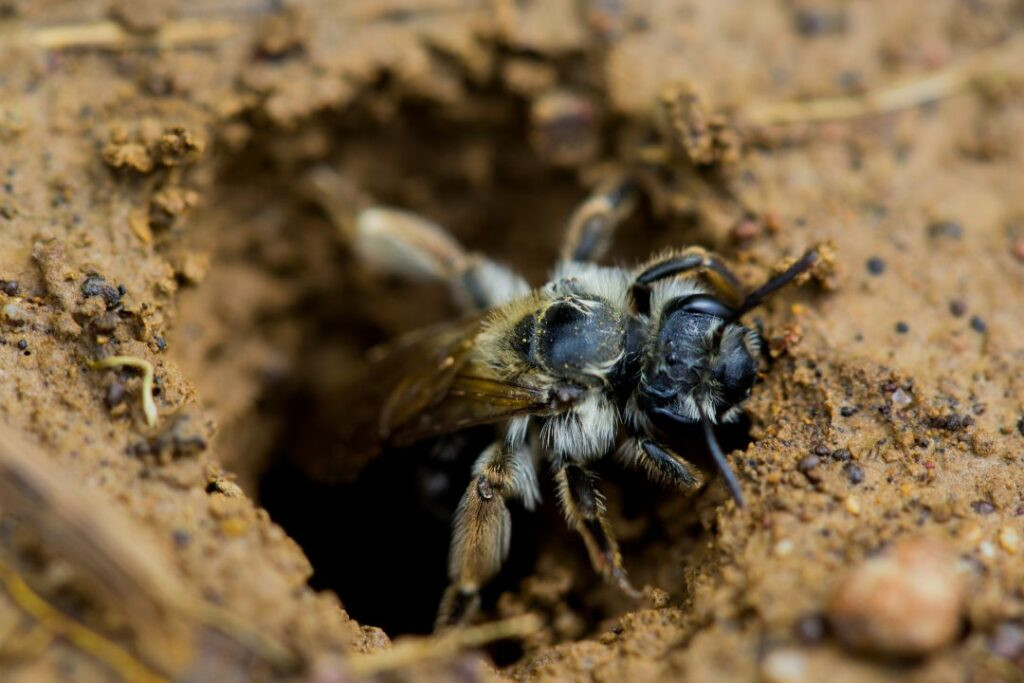Bees’ inability to fly can be concerning, but flyermedia.net is here to help you understand why it happens and what you can do to assist these vital pollinators. We provide practical guidance, from offering a simple sugar solution to identifying signs of distress, ensuring you’re well-equipped to support bees in need. Learn about bee care, habitat preservation, and helpful resources like bee revival kits.
1. Why Can’t a Bee Fly?
There are several reasons why a bee might be grounded. Understanding the cause is crucial for providing the right kind of help. Here’s a breakdown of potential issues:
- Resting: Bees, especially larger bumblebees, expend a lot of energy flying. They often rest between flights to conserve energy.
- Exhaustion: Bees in urban areas may struggle to find enough food to fuel their flight.
- Nesting: Some bees, like solitary bees, nest in the ground. A bee on the ground might be protecting its nest.
- Wing Damage: Bees can lose or fail to develop their wings, often due to the Deformed Wing Virus (DWV).
- Wet Wings: Rain or accidental submersion can waterlog a bee’s wings, making it unable to fly.
2. Is the Bee Simply Resting or in Distress?
Before intervening, observe the bee for a while. Sometimes, a bee just needs a break.
How Long Should I Wait Before Helping a Bee?
Wait at least 45 minutes. Bumblebee queens, in particular, are known to rest for this long on flowers to rejuvenate. Intervening too soon can distress a healthy bee and cause it to fly prematurely, potentially leading to exhaustion and disorientation.
What if the Bee is in Danger While Resting?
If the bee is in a hazardous location (e.g., road, construction site), gently move it to a safer spot, such as a nearby leaf or flower. Avoid handling the bee directly to prevent stings.
3. How to Help a Tired Bee
If the bee seems exhausted and unable to fly after a reasonable resting period, it might need a boost of energy.
What Can I Give a Bee That Can’t Fly?
A simple sugar-water solution can provide the bee with the energy it needs. Mix two teaspoons of white sugar with one teaspoon of water. Place a small drop of the solution near the bee, such as on a spoon or a shallow dish. Do not use honey as it can contain pathogens harmful to bees. According to research from the University of California, honey can transmit diseases between bees.
Is There a Better Alternative Than Sugar Water?
Consider using a Bee Revival Kit. These kits contain specially formulated syrup designed for bee health, often including essential nutrients.
 Bee drinking sugar water
Bee drinking sugar water
Alt text: A bee drinking sugar water from between two pebbles.
4. What if the Bee is Burrowing?
Some bees nest in the ground. If you see a bee entering or exiting a hole in the ground, it’s likely a ground-nesting bee.
How Should I Handle Ground-Nesting Bees?
Leave them alone. These bees are simply going about their normal activities. If possible, cordon off the area to protect the nest from disturbance.
When Will the Bees Emerge from the Ground?
Young larvae or overwintered bees will typically emerge as the ground warms up in the spring.
5. What if the Bee Has No Wings?
A bee without wings is a serious concern and could indicate Deformed Wing Virus (DWV).
What is Deformed Wing Virus (DWV)?
DWV is an RNA virus that affects honeybees and some bumblebee species. Symptoms include underdeveloped wings, abdomens, legs, and thorax. Bees with DWV have significantly reduced lifespans.
Can I Help a Bee with Deformed Wing Virus?
Unfortunately, there is little chance of survival for bees unable to fly due to missing or damaged wings. Returning them to the hive could spread disease. The best course of action is to leave the bee alone or move it to a sunny spot if it’s in immediate danger.
6. How to Help a Wet Bee
If a bee is wet, its wings might be too heavy for flight.
What Should I Do with a Wet Bee?
Move the bee to a sheltered location outdoors where it can dry off. If it’s raining, find a tree or bush for cover. If it’s sunny, place the bee in direct sunlight. Waterlogged bees will often bask in the sun to dry their wings.
Should I Bring the Bee Inside?
No. Bringing a bee indoors is not recommended, as it’s an unnatural environment that can distress them.
 Nesting Bee
Nesting Bee
Alt text: A nesting bee leaving its hole in the ground.
7. Understanding Bee Behavior
Knowing a little about bee behavior can help you determine the best course of action.
Are Bees Pets?
No, bees are not pets. While it’s natural to want to help them, human interaction can be frightening for bees. The best way to support bees is to provide them with the resources they need to thrive.
How Can I Provide Resources for Bees?
Planting colorful flowers rich in nectar and pollen is a great way to support bees. You can also create a bee-friendly garden by providing a water source and avoiding pesticides.
8. What is the Best Way to Help Bees?
In most cases, the best way to help a bee that can’t fly is to observe it from a distance and intervene only if necessary. If the bee is in danger, provide a temporary energy boost with a sugar-water solution, or help it dry off.
9. Deeper Dive into Bee-Related Issues
Let’s explore some common scenarios that may lead to a bee being unable to fly and how to handle them.
9.1. Pesticide Exposure
Pesticides are a major threat to bee populations. Exposure to pesticides can cause a range of problems, including impaired flight, disorientation, and death.
How Can I Tell if a Bee Has Been Exposed to Pesticides?
Signs of pesticide exposure include erratic behavior, tremors, paralysis, and difficulty flying.
How Can I Help a Bee Affected by Pesticides?
Unfortunately, there is often little you can do to help a bee that has been severely affected by pesticides. However, you can try to move the bee to a safe location and provide it with a sugar-water solution. The best approach is prevention. Avoid using pesticides in your garden, and encourage your neighbors to do the same.
9.2. Mite Infestations
Mites, such as Varroa mites, are parasites that can weaken bees and transmit diseases. Mite infestations can lead to deformed wings and reduced flight ability.
How Do Mites Affect Bees?
Varroa mites feed on bee larvae and adults, weakening them and making them more susceptible to diseases. They can also transmit viruses, such as DWV.
What Can Be Done About Mite Infestations?
Mite infestations are a serious problem for beekeepers. Various treatments are available, including chemical treatments and organic methods. If you suspect a mite infestation in your area, contact a local beekeeping association for advice.
9.3. Queen Bee Issues
The queen bee is essential to the health and survival of a honeybee colony. If the queen is weak, old, or diseased, the colony may decline, and individual bees may be affected.
How Does the Queen Bee Influence the Colony?
The queen bee lays all the eggs in the colony and produces pheromones that regulate the colony’s behavior. A healthy queen is essential for maintaining a strong and productive colony.
What Happens if the Queen Bee Dies?
If the queen bee dies, the colony will eventually collapse unless the beekeeper introduces a new queen.
10. Conservation Efforts: Protecting Bees
Helping individual bees is important, but the best way to support bee populations is to promote bee conservation.
10.1. Planting Bee-Friendly Gardens
One of the most effective ways to help bees is to plant bee-friendly gardens. Choose a variety of flowers that bloom at different times of the year to provide a continuous source of nectar and pollen. Native plants are often the best choice, as they are adapted to local conditions and provide the most nutritious food for bees. According to the U.S. Forest Service, native plants provide four times the food value for native pollinators compared to non-native plants.
10.2. Providing Water Sources
Bees need water to drink and to regulate the temperature of their hive. Provide a shallow dish of water with pebbles or marbles for the bees to land on.
10.3. Avoiding Pesticides
Pesticides are harmful to bees and should be avoided whenever possible. If you must use pesticides, choose the least toxic option and apply it carefully, following the instructions on the label.
10.4. Supporting Local Beekeepers
Local beekeepers play an important role in bee conservation. Support them by buying local honey and other bee products.
10.5. Educating Others
Educate your friends, family, and neighbors about the importance of bees and what they can do to help. Share information about bee-friendly gardening, pesticide avoidance, and other conservation measures.
FAQ: Helping Bees
1. What is the best thing to give a bee that can’t fly?
A sugar-water solution (2 parts sugar to 1 part water) is the best quick energy source for a tired bee.
2. Why is a bee on the ground not moving?
It could be resting, exhausted, sick, injured, or exposed to pesticides.
3. How long should I wait before helping a bee?
Wait at least 45 minutes to see if it’s just resting.
4. Can I give honey to a tired bee?
No, honey can contain pathogens harmful to bees. Use a sugar-water solution instead.
5. What does Deformed Wing Virus do to bees?
It causes underdeveloped or damaged wings, making it impossible for the bee to fly.
6. Is it OK to bring a bee inside to help it?
No, it’s best to leave it outside in a sheltered location.
7. How can I tell if a bee is nesting in the ground?
You’ll see bees entering and exiting small holes in the ground.
8. What should I do if I find a bee covered in pesticides?
Move it to a safe location and provide a sugar-water solution, but its chances of survival are low.
9. Why are bees important?
Bees are essential pollinators, playing a crucial role in food production and ecosystem health.
10. How can I help protect bees?
Plant bee-friendly gardens, avoid pesticides, provide water sources, and support local beekeepers.
Conclusion: A Bee in Need
Knowing how to help a bee that can’t fly is a valuable skill. By understanding the potential causes and following the simple steps outlined in this guide, you can make a difference in the lives of these important pollinators. Remember, even small actions can have a big impact. Explore more about beekeeping, bee conservation, and how to create bee-friendly habitats on flyermedia.net today! If you’re interested in aviation and how it intersects with environmental concerns, you might also find related articles on our site. Check out flyermedia.net for insightful articles, including information on flight training and career opportunities in aviation. For further inquiries, feel free to contact us at Address: 600 S Clyde Morris Blvd, Daytona Beach, FL 32114, United States or Phone: +1 (386) 226-6000.